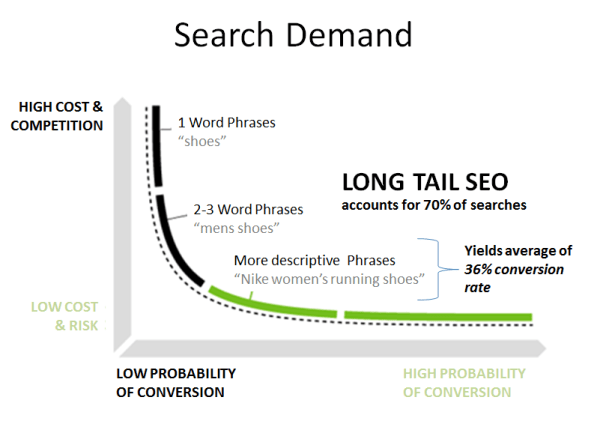While I don’t consider myself a black-hat SEO, I find it fascinating to experiment and learn from those who work in the most competitive niches and who push the boundaries as to what is possible in SEO.
Five years ago I ran a popular experiment where I built 10,000 links to a domain in 24 hours. To my surprise, the site ranked #1 for a competitive keyword for about two weeks. When the rest of the industry was preaching that these tactics were ineffective, I showed that they did in fact work quite well for targeting seasonal keywords.
My takeaway from that experiment, which I believe is still relevant today, is that the effectiveness of SEO tactics is highly contextual, and your level of competition plays a big role in that context.
In this post, I want to walk through three strategies for ultra-competitive SEO. I’ve avoided talking about tactics, as they’d inevitably become outdated and it’s not my specific area of expertise.
To get started, I want to talk about a strategy that’s traditionally reserved for investment bankers and high-frequency traders; hedging.
1. Hedging Your SEO Strategy
Hedging is a risk management strategy used to offset the probability of loss. In laymen terms, it simply means not putting all of your eggs in one basket.
Just like in an investment portfolio, where spreading your money between stocks, bonds, and commodities can hedge against swings in the economy, a well-hedged SEO strategy can protect you from swings in the Google algorithm.
Last year I heard about a brand in the online gambling industry who had one of the most interesting SEO strategies I’ve ever heard of.
This brand had three separate SEO strategies that were all isolated from each other (the results of one did not affect the others), and more importantly, they were all hedged against each other so that the company would, in theory, benefit regardless of whether Google decided to increase the priority of brands, content marketing, spammy link building, exact-match domains, or a variety of other variables.
In a nutshell, their strategy looked like this:
Strategy A (long term / white hat) – The main strategy, which consumed the majority of time, effort and budget, was the long-term white hat strategy. This strategy focused on a diverse range of white-hat link building / content marketing, and brand building tactics. This strategy is the only one to be used on the brand’s main domain(s).
In the short-term, this strategy was relatively ineffective, as most of the their competitors were being very aggressive with black-hat tactics that occupied the most competitive search terms.
Over the long-term, though, this strategy betted on the likelihood that Google would prioritise brands in the SERPs, and make it harder for black hats to rank for competitive commercial terms. Given the signals, that’s a pretty safe long-term bet.
Strategy B (medium term / grey hat) – Their medium term strategy included a series of grey-hat tactics such as buying competitor sites / setting up micro-sites, and building a varied range of links to them.
This strategy betted on the probability that certain tactics, like scaled guest blogging and widget links, will probably still work for another six-twelve months or so, but not in 3-5 years.
Strategy C (short term / black hat) – Their short-term strategy took an extremely aggressive churn and burn approach. While I don’t know the specifics, I suspect that they were buying hundreds of domains, building large quantities of links to them, and getting these sites to rank for a couple of weeks, before they repeated the process over and over again.
If you wanted to take it to the next level, you could even add multiple layers of diversification within strategies A, B, and C. For example, by targeting different markets, languages, and tactics within each strategy.
While the example above is a relatively extreme case study, I personally believe that every marketer should apply a degree of hedging, or diversification, to their strategy. Given the amount of unknowns in SEO, and digital marketing in general, it can be risky to put all of your eggs in any basket – white-hat or black-hat.
For companies in ultra-competitive niches like pharma, online gambling, adult, and finance, hedging multiple strategies is almost a necessity. The downside of this approach is that it’s expensive and arguably wasteful. It’s only wasteful in hindsight, though.
2. Out-thinking, Out-Working, and Out-Branding the Competition
When it comes to winning the game of ultra-competitive SEO, you need to have a solid plan for how you’re going to beat the competition. As with many games, there is more than one way to win. You could, for example:
- Out-brand the competitors
- Out-working the competitors
- Out-thinking the competitors
Out-branding the competition
Earlier last year I read Marc Benioff’s book, Behind the Cloud, where he explains the story behind Salesforce.com’s growth. In it, there was some great advice on positioning: position yourself as Goliath, or against the Goliath. Nothing in between.
In SEO, many competitive niches, such as pay day loans and credit cards, have been won by underdogs who out-branded their large laggard competitors.
Take MoneySuperMarket or CompareTheMarket, who rank #1 and #2 for ‘compare credit cards’, among many other competitive keywords. Despite effectively being affiliate sites, they’ve beat all of the banks, financial institutions, and financial press who were previously competing over these terms.
How did they do it? By out-branding them with meerkats, mostly.

Another great example of out-branding in ultra-competitive SEO niches is Wonga.com.
By sponsoring football teams, running TV ad campaigns, and investing in a lot of brand-building and educational content, Wonga now rank #1 in Google for ‘Pay Day Loans’, one of the most competitive financial search terms.

Out-thinking the competition
If you haven’t read Predatory Thinking by Dave Trott, leave this website and add it to your Amazon Wishlist. I promise it’ll be among the best books you read this year.
Without spoiling the content, the premise of his book is that, no matter how large or small you are, you can eat your competition’s market share by thinking smarter than them. While the book contains stories that can be applied to all walks of life, the concept of out-thinking the competition is extremely relevant to SEO.
One example of out-thinking your competition in SEO is to swim upstream and focus on a different portion of your market. We’ll talk more about this in the next section.
Out-working the competition
Last year I examined how six popular blogs reached over 1,000,000 monthly visitors/month in just a few years. Bear in mind, that these six blogs, including Mashable and ProBlogger, were one-man projects competing against websites with tens or hundreds of journalists.
Almost exclusively, they won by out-hustling their competitors. At one point, Pete Cashmore (founder of Mashable) was writing 7 blog posts per day, more than what most of his competitors were publishing in a week.
To out-hustle your competition in an ultra-competitive niche, you’ll need some fire in your belly and a true passion for what you’re doing. Out of the three options, it’s by far the most work.
3. Re-Focus on a Different Portion of Your Market
The majority of your competitors are likely focusing on the same small collection of keywords. One strategy for out-thinking your competitors is to swim upstream and target a different portion of market, perhaps more long tail or ‘mid tail’ focused.

Another good example of refocusing is to target an entirely different geographic market or language, if it makes sense to from a business perspective. In this post, I explained how one guy reached over 1 million visitors / month in under six months by targeting Japanese keywords, even though he couldn’t speak Japanese.
You could also consider re-focusing on a different part of the sales funnel. If everyone in your niche is focusing at the top of the sales funnel e.g. ‘what are the best online casinos?’, you could re-focus on keywords that are closer to the sign-up process e.g. ‘online casino bonuses’ to capture more converting traffic.
In Summary
When it comes to ultra-competitive SEO, you need to be beat your competitors in at least one area. Whether that’s out-smarting them, out-working them, out-spending them, or simply persisting for longer than them, you need to have enough focus on an area that you can win at.
We’ve just touched on a few potential strategies here, so I’d encourage you to think about other ways in which you can beat your competition. Hopefully this has helped spark a few ideas to get you started.



